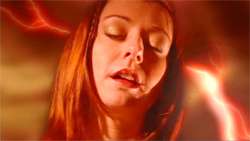
Wrecked (Buffy the Vampire Slayer)
"Wrecked" is the 10th episode of season 6 of the television series Buffy the Vampire Slayer.
Plot synopsis
Tara and Dawn wake on the couch and find that neither Buffy nor Willow returned home the night before. Buffy wakes up naked with Spike to find that the building around them fell down as she remembers what they did. Spike tempts Buffy as she tries to leave and reminds her of everything they did the night before. He angers and disgusts her, but while she searches for her clothes Spike asks her to stay. Buffy appears on the verge of agreeing before Spike makes a comment about their night together, and she leaves, threatening to kill him if he tells anyone about what happened between them.
Amy returns home with Willow and rambles about Willow's amazing magic – in front of Tara and Dawn. Tara leaves as Buffy returns, and after a chat, Amy leaves and Buffy and Willow go to bed after their long nights. Willow tries to shut the drapes of her room with magic, but she is too exhausted to manage it. Anya reads bridal magazines instead of researching the freezing demon. Xander gets frustrated, finding bridal magazines in every research book he checks. At the magic shop, Xander, Anya and Buffy discuss Willow's behavior and Buffy comes to Willow's defense.

Buffy the Vampire Slayer
Buffy the Vampire Slayer is an American television series created by Joss Whedon under his production tag, Mutant Enemy Productions with later co-executive producers being Jane Espenson, David Fury, David Greenwalt, Doug Petrie, Marti Noxon, and David Solomon. The series premiered on March 10, 1997, on The WB and concluded on May 20, 2003, on UPN. The series narrative follows Buffy Summers (played by Sarah Michelle Gellar), the latest in a line of young women known as "Vampire Slayers", or simply "Slayers". In the story, Slayers are "called" (chosen by fate) to battle against vampires, demons, and other forces of darkness. Like previous Slayers, Buffy is aided by a Watcher, who guides, teaches, and trains her. Unlike her predecessors, Buffy surrounds herself with a circle of loyal friends who become known as the "Scooby Gang".
The series received critical and popular acclaim and usually reached between four and six million viewers on original airings. Although such ratings are lower than successful shows on the "big four" networks (ABC, CBS, NBC, and Fox), they were a success for the relatively new and smaller WB Television Network. The show was ranked 41st on TV Guide's list of 50 Greatest TV Shows of All Time, second on Empire's "50 Greatest TV Shows of All Time", voted third in 2004 and 2007 on TV Guide's "Top Cult Shows Ever" and listed in Time magazine's "100 Best TV Shows of All-Time". In 2013, TV Guide also included it in its list of "The 60 Greatest Dramas of All Time" and ranked it #38 on its list of the "60 Best Series of All Time".Buffy was also named the third Best School Show of All Time by AOL TV. It was nominated for Emmy and Golden Globe awards, winning a total of three Emmys. However, snubs in lead Emmy categories resulted in outrage among TV critics and the decision by the academy to hold a tribute event in honor of the series after it had gone off the air in 2003.

Buffy the Vampire Slayer: The Album
Buffy the Vampire Slayer: The Album is a soundtrack album featuring music from the Buffy the Vampire Slayer TV series.
The album is made up mostly of tracks by little-known artists, though some better known ones, such as Garbage and Alison Krauss, are also featured. A small part of the television show's original score is also included. Although the album was released in 1999, it contains music from Buffy's first four seasons.
A follow up, Buffy the Vampire Slayer: Radio Sunnydale – Music from the TV Series, was released in 2003.
Track listing
Buffy the Vampire Slayer (disambiguation)
Buffy the Vampire Slayer may refer to:
Publications
Music
Wrecked
Wrecked may refer to:
See also

Wrecked (album)
Wrecked is a 1996 album released by Raymond Watts (as PIG). Wrecked was originally released in Japan in 1996, and was later released in the United States on September 16, 1997 by Wax Trax/TVT Records. Each release is different, with different track run times, as well as different tracks present. A promotional video for 'Everything' exists, but remains unreleased outside Japan.
Track listing
Original (Japanese) release
US release

Vampire
A vampire is a being from folklore who subsists by feeding on the life essence (generally in the form of blood) of living creatures. Undead beings, vampires often visited loved ones and caused mischief or deaths in the neighbourhoods they inhabited when they were alive. They wore shrouds and were often described as bloated and of ruddy or dark countenance, markedly different from today's gaunt, pale vampire which dates from the early 19th century. Although vampiric entities have been recorded in most cultures, the term vampire was not popularized in the west until the early 18th century, after an influx of vampire superstition into Western Europe from areas where vampire legends were frequent, such as the Balkans and Eastern Europe, although local variants were also known by different names, such as shtriga in Albania, vrykolakas in Greece and strigoi in Romania. This increased level of vampire superstition in Europe led to what can only be called mass hysteria and in some cases resulted in corpses actually being staked and people being accused of vampirism.
Podcasts:

